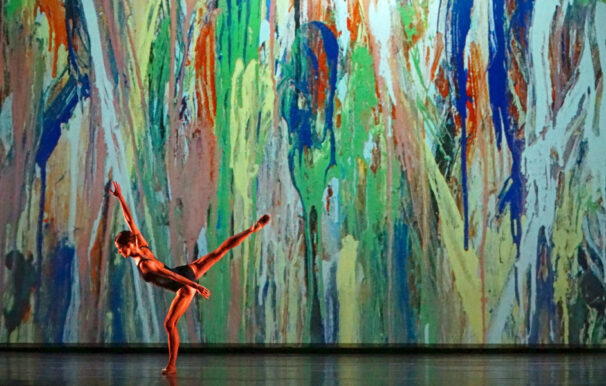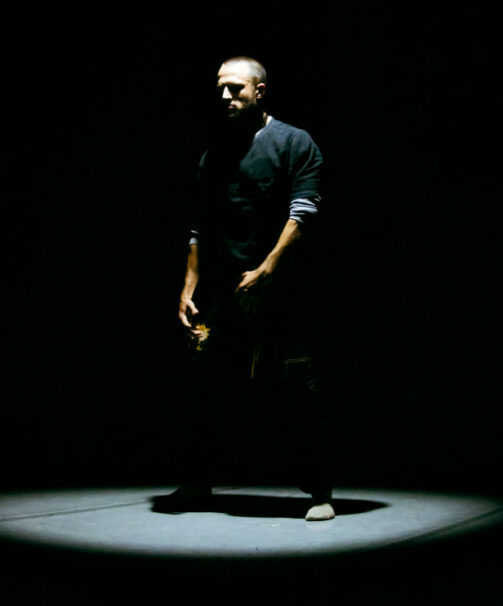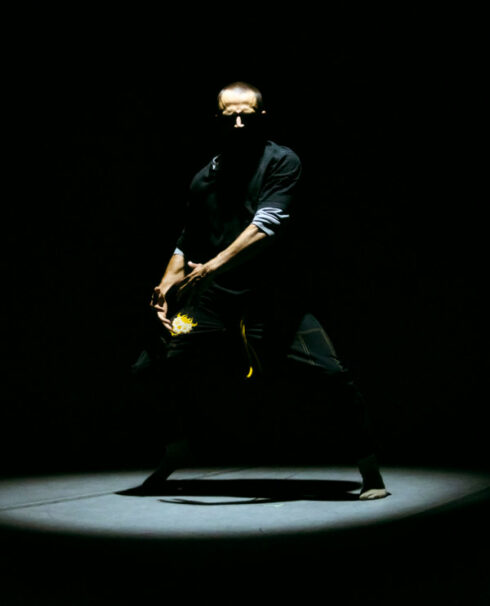
Los Angeles has long been an industrial hub; over this city’s relatively youthful history, we’ve been a maker of stuff: first oranges and lemons; then a film industry begun on a wooden platform under the noonday sun; next, aerospace and widget manufacturing to prosecute a world war and man’s first step on the moon; then garments for the ladies and toys for the kids. Lately, we see a resurgence of manufacturing — in the dance world — by two deeply committed male choreographers, Raiford Rogers and Tony Testa.


One prodigious creator is Raiford Rogers, whose admirably abstruse exhibition we viewed recently at the populist Luckman Fine Arts Complex in East Los Angeles. Rogers, a dance maker of decades, presented two highly polished works on his program, the first, “Seeds of Rain,” made in 2022 to organ music by Philip Glass (its sound muted if not murky on the Luckman sound system) and new music by Czech composer Zbynek Mateju.
Rogers as a choreographer has long been inspired by neo-classical masters. That hasn’t changed, but he’s gotten better and better at it. Enchanted by classical ballet technique, he constantly renews and refreshes his dedication to that specific dance language. He’s got a fine eye, and the best evidence is the troupe he assembled of the top practitioners in the town … guys and girls with fat-free body-beautifuls, each comporting with his unforgiving technical demands. Rogers is not a choreographer of flow. He’s a choreographer of design, geometry, and position. The work is much in the legs, although the shapes he aims for are often instigated by a downward sweep of the arms and an upward lift of the leg.
“Ballet Etudes,” again to music by Glass, like “Seeds” had stunning mise en scene with “Painting Projections” backdrops by Mike Nava and lighting by John A. Garofalo. In lengthy, ponderous, and technically challenging solos, trios and other groupings, he unleashes chains of classical movement with an emphasis on leg extensions in every direction; then, around the tautly held torso, he pivots and circles those legs into shapes and forms. His musicality is admirable and extends the range for both dancers and audience, as in uptempo moments he sends his dancers scattering. The choreography, at its weakest nearly classroom exercises, is enlivened when situated within the production environment that clearly comprises Rogers’s total vision. I found getting lost in this work’s vicissitudes to be rather pleasant, if not somewhat dulling. Kudos to Rogers’s hard-working dancers for delivering this difficult material.


Another stalwart Los Angeles dance maker with a resume as long as his arm in the commercial dance space is Tony Testa. Testa’s “Blackbox 1: Excerpt” was a distinctive add to “Congress,” a old-fashioned choreographer’s showcase on steroids staged at L.A. Dance Project’s nearly cruelly isolated studio. The showcase was amped in the vociferous cult-like atmosphere enjoyed by Los Angeles’s community of commercial dancers. This is a wildly energized, youthful audience, in which foot stomping is officially sanctioned along with whooping and screaming at performers. The boisterousness, one assumes, galvanizes those performing.
Testa nearly blundered his way into the studio space configured in the round. Blinded by his own closed eyes, he advanced to the unmuffled sound of his tap shoes. I found the click-‘n-clack a thrilling invitation to the dance. How better for a dancer to announce his arrival on a stage? And take the stage Testa did, moving directly to a downstage-center spotlight where, as a Dance Everyman, a somewhat hulking presence, he lurched through a rapid-fire series of high-intensity vignettes punctuated by black-outs. These danced anecdotes ran a narrow spectrum from harrowing to nightmarish. One had him flipping out beneath a strobe light; another had his head crowned by aluminum industrial lamp lowered from the beams; in another, he donned a baseball cap and popped as a smooth B-boy; next thing, we see him flat out on the floor with weird steam rising from his body. That evoked a corpse in a fetid graveyard … or could it be Maui?
The explorations were cinematic, freaky, disturbing and I sense no one in the room who went through COVID would have to struggle to understand or accept what he was putting out. It was scary, somewhat bestial, but … you understood it. I was left wanting more, and apparently Testa has more coming. “Blackbox 1: Excerpt” as its name implies, is augured as a work in progress.
Photo credits:
For Raiford Rogers: Anne Trelease
For Congress VIII: @the1point8
Dance critic Debra Levine’s feature articles, reviews, and interviews have been published in the New York Times, Los Angeles Times, DANCE Magazine, EMMY Magazine, South China Morning Post, and more. She is the author of an upcoming biography of the choreographer Jack Cole.
